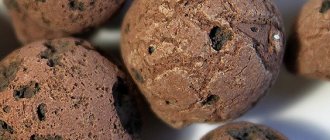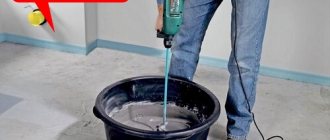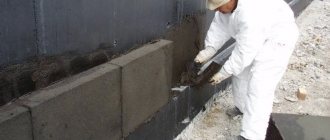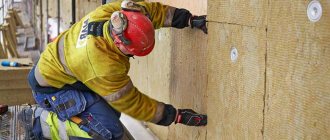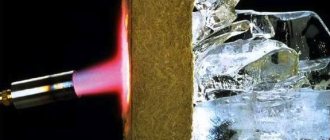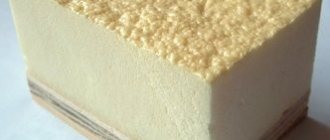The thermal insulation properties of expanded clay are well known and are largely determined by the raw materials from which it is produced. The thermal conductivity of expanded clay is one of its main characteristics, which, together with its low specific gravity and strength, determines the widespread use of this material in construction.
In this article: [Hide]
- What affects the thermal conductivity of expanded clay Expanded clay crushed stone
- Expanded clay gravel
- Expanded clay sand
- Production processes affecting the thermal conductivity of expanded clay
Characteristics and application of construction expanded clay
Energy prices are rising rapidly, which entails an increase in demand for thermal insulators. Expanded clay is an effective insulation material that does not require special installation skills. Possessing a porous structure, it is often used as a filler for concrete. The best raw materials for making expanded clay are considered to be clays that contain 30% quartz. When the base rock is expanded, thanks to a special firing mode, the output is high-quality material in the form of grains. Their properties depend on the faction.
In the finished state, expanded clay has the appearance of crushed stone or gravel or sand.
Therefore, classification is often carried out taking into account the size of the fractions and their shape, which can be:
- rounded, characteristic of gravel. It is divided into grades according to the size of the fraction: 10–20 mm (suitable for arranging communications), 30–40 mm (use associated with backfilling in a large layer), 5–10 mm (most in demand for preparing concrete mortar);
- angular, which distinguishes crushed stone. The grain sizes vary within the same limits as those of gravel. May be useful for insulating bathhouse walls;
- from spherical to indeterminate. Inherent in small particles (up to 5 mm) in the form of sand. It is obtained by crushing large pieces or isolated by firing small pieces of clay.
Some properties of expanded clay distinguish it from other similar materials.
Widespread use is due to the following characteristics:
- Biological safety, since the raw material for its production is an environmentally friendly natural product.
- Fire resistance. Does not burn and does not support combustion.
- A significant indicator of heat and sound insulation, achieved thanks to the porous structure, which is formed as a result of gases released during firing. Sound insulation directly depends on the level of porosity.
- Durability.
- Relative moisture resistance.
- High frost resistance: varies from 15 units to 50.
- Resistance to external aggressive factors.
The advantages are also a high level of thermal insulation and low cost. For comparison, the efficiency of wood is almost three times lower, and the use of brickwork will cost more.
The thermal conductivity of expanded clay depends on the grain size. The finer the fraction, the fewer voids remain between the particles. It follows from this that the bulk density increases, which means that the thermal insulation properties deteriorate.
Granules tend to absorb water. Therefore, it is still preferable to use them in the form of dry backfill; they are also quite fragile.
Thermal insulation requires protection against moisture penetration. Good waterproofing is required. It is advisable to use different fractions.
Place in the construction industry
The areas of application are quite extensive. For old buildings, it is important to use it as part of the foundation. A mortar screed with a thickness of more than 3 cm is usually made on top. Due to the low weight of expanded clay, the total weight of the entire structure will be significantly reduced.
The widespread use of bulk products of different fractions is due to its versatility. Expanded clay is an indispensable component in the production of lightweight concrete.
In addition, expanded clay is an effective floor insulation material. It is also a good heat insulator for utilities, foundations, partitions, and roofing. Additional advantages from the work carried out: sound insulation is significantly improved (due to the excellent sound-absorbing properties of the material).
Volumetric weight ranges from 300 kg/m3 and often reaches 1,000 kg/m3. When compressing expanded clay crushed stone, the tensile strength varies from 25–200 kg/cm2.
If you measure the weight of expanded clay of different fractions in the same units, it will be different. After all, the mass depends on the size of the granule, and accordingly, on the bulk density, which is determined by its brand according to GOST 9757-90. For example, taking fractions with a bulk density of M300, you can be sure that the cubic meter of volume in its entirety will be from 250 kg/m3 to 300 kg/m3.
It is better to purchase small quantities of goods in bags. It is worth remembering that volume is taken as a basis, not weight, which will differ depending on the bulk density of the product and the volume of the container.
| Brand, fraction size | Packing in bags, m3 | Price, rubles |
| M650, 0–5 mm | 0,035–0,04 | 96–98 |
| M600, 5–10 mm | 0,035–0,06 | 80–115 |
| M500, 10–20 mm | 0,035–0,06 | 72–110 |
| M450, 20–40 mm | 0,035–0,06 | 71–109 |
Today it is possible to purchase expanded clay in bags or in bulk. Typically, regular customers are provided with prices by agreement.
What is mineral wool
Mineral wool is one of the most common heat insulators, used in various types of insulation. Mineral wool is a soft, coarse-fiber building material. Mineral wool insulation is produced from metal waste and carbon alloys of minerals.
Mineral wool is widely in demand in construction due to its durability, simple and quick installation, and fire resistance. The disadvantage of this insulation is its reduced moisture resistance. To protect against dampness, the material is impregnated with special compounds.
The property of mineral wool such as breathability is especially valued. Due to its ability to “breathe”, mineral wool is often used to insulate wooden houses. Mineral wool insulation form: slabs, rolls, mats of various lengths and thicknesses. The choice of slab size depends on the conditions of thermal insulation installation and the upcoming tasks.
For summer houses, the insulation dimensions will be smaller. So for a panel country house you will need sheets 50 mm thick. Houses for year-round use require more thorough insulation; in this case, the required thickness of the mineral wool layer reaches 200 mm.
Expanded clay. Floor insulation in a private house
Publication date: 01/21/2017
If you need to save on the purchase of building materials and escape the cold season, you can use thermal insulation of the floor covering using expanded clay. This insulation is affordable and one of the most convenient, and if the work is done correctly, it will also be durable. The work is not difficult if you do not have certain experience, but it is better to study the technology of work first.
Material characteristics
Expanded clay can be classified as a loose insulation material; it is represented by oval and round granules, inside of which there is a porous structure. This material is obtained by firing clay, after which it acquires low weight and high strength. Three types of expanded clay fraction are used in construction: sand, gravel and crushed stone. If you compare 10 centimeters of expanded clay and 1 meter of brick, the thermal insulation properties will be the same. Expanded clay has a low cost, excellent sound insulation properties, it is an environmentally friendly and durable material, has the ability to retain heat, it can withstand any temperature, is durable and has a low weight. Among the disadvantages, one can highlight hygroscopicity; if moisture gets into the product, it will remain there for a long time, which means that expanded clay will begin to lose its properties. Expanded clay begins to deform, which means the floor covering will also be subject to deformation. If you decide to work with expanded clay, waterproofing is first carried out.
There are three ways to insulate a floor with expanded clay: combined, dry expanded clay, expanded clay in a concrete mixture. With the dry method, expanded clay is poured into special niches, after which a subfloor is laid on top. A layer of waterproofing material is pre-laid at the base of the floor. To achieve high thermal insulation, different fractions of the material are mixed before backfilling. Thus, insulation is carried out quickly and does not require much effort. If expanded clay is laid using the wet method, it is mixed with concrete, after which this mixture is poured into the prepared space.
If there are large differences from the surface, then this option will be the best. Expanded clay is very light, so there will be little load on the base, the screed will dry quickly and will not crack. With the wet method, thermal conductivity properties increase. When performing combined insulation, dry expanded clay is poured and leveled in the recess. Cement mortar is poured on top, the screed dries, the expanded clay layer is strengthened and is not subject to deformation. In this case, you can use reinforcing mesh if operation involves a large load.
Expanded clay technical characteristics
Expanded clay has different technical characteristics of fractions 20-40 and 10-20. In this article we will consider its properties and varieties, application in construction and in the production of building materials. Despite the emergence of new materials for thermal insulation, this insulation is still in demand. It is impossible to imagine modern construction without the use of expanded clay.
Expanded clay is a natural and environmentally friendly thermal insulation material with a fraction of 10 to 40 mm. The material is obtained by firing special types of clay in high-temperature ovens. This clay swells when heated sharply, resulting in a durable bulk thermal insulation material with low weight, but with a low thermal conductivity coefficient - this property applies to all fractions from 10 to 40 mm.
Description and types of expanded clay
Expanded clay has some advantages in comparison with Tekhnoruf mineral wool. Most mineral insulation materials decompose and cake over time. Expanded polystyrene emits harmful substances and is a fire hazard. Expanded clay is environmentally friendly, does not decompose, is resistant to moisture and open flame, and has good heat and sound insulation.
This porous material is one of the most effective for thermal insulation, which is in great demand in the production of building materials (expanded clay concrete, lightweight concrete, etc.) and insulation of residential buildings (insulation of columnar foundations, floors on the first floor of the house, etc.). The main properties are: grain fraction, bulk density and strength. See the photo below for the use of the material.
Varieties of expanded clay
Expanded clay sand has a fraction size from 0.14 to 5 mm. It is used as a filler for concrete and mortars, for thermal insulation of floors and interfloor ceilings with low backfill thickness (up to 50 mm).
Expanded clay gravel has fraction sizes from 5 to 40 mm. It is used as a filler in the production of lightweight concrete, for thermal insulation of horizontal surfaces on roofs and floors.
Expanded clay crushed stone has a fraction size from 5 to 40 mm. The material is obtained by additional crushing of large pieces of expanded clay, because of this the crushed stone has an irregular and angular shape.
Technical characteristics of expanded clay
In appearance, expanded clay is a round-shaped porous material granules of various sizes. It is used extremely widely in construction today; the main purpose of the material is to insulate structures during construction, as well as to reduce the weight of building materials during their production without loss of strength. See the characteristics of bulk thermal insulation in the table below.
Expanded clay thermal conductivity by fractions
Expanded clay is divided into gravel fractions: 5-10 mm; 10-20 mm; 20-40 mm and sand (0-5 mm). Based on density and strength, gravel is divided into grades from M300 to M700. These numbers indicate bulk density, but do not indicate the strength of the material or its thermal conductivity. Technical characteristics of expanded clay in terms of strength and bulk density:
- Fraction 20-40 mm (M300 - M380) - gravel strength grade P50 - P75
- Fraction 10-20 mm (M400 - M450) - gravel strength grade P75 - P100
- Fraction 5-10 mm (M500 - M550) - gravel strength grade P100 - P125
- Fraction 0-5 mm (M600 - M700) - gravel strength grade P50 - P75
Expanded clay thermal conductivity characteristics
Use of expanded clay in construction
- Thermal insulation of floors, ceilings, attics, basements;
- Thermal insulation of strip foundations and blind areas of houses;
- Thermal insulation of flat roofs, creating a slope on the roof;
- Production of expanded clay concrete blocks and lightweight concrete;
- Thermal insulation of soil - lawns and drainage on the site;
- Thermal insulation of communications; in case of repairs, expanded clay is reused;
- Hydroponics, expanded clay creates an optimal microclimate for plant roots.
When laying expanded clay, it should be protected from getting wet and absorbing moisture with a waterproofing film (polyethylene, roofing felt, etc.).
As you can see, the scope of application of this insulation in construction and in the home is diverse, which can be explained by the excellent thermal conductivity, environmental safety and strength of the insulation. In addition, the material is free-flowing and takes any shape; it can be used to fill any media. When used correctly, it can reduce heat loss in the room by 50-75%.
(
5,00 out of 5)
Insulating the attic with mineral wool
To prevent the attic from being empty, it can be insulated and turned into an additional attic room or storage room. For thermal insulation of the attic space the following are used:
- Organic derivatives (polyurethane foam).
- Mineral wool materials.
- Bulk dry insulation (expanded clay).
For high-quality thermal insulation of the attic, all three types of materials are used and combined.
Mineral wool is well suited for insulating all surfaces of the attic: floors, walls and roof. Insulating an attic with mineral wool requires the additional use of external wind- and water-insulating polymer film. It is advisable to treat the metal surface of the roof with oil paint to prevent condensation during the cold season of the year.
Mineral wool has a loose structure and allows steam to pass through well, so the inside of the insulation is covered with a vapor barrier layer of foil polyethylene.
Mineral wool is used in the form of rolls and mats. The seams between individual fragments of insulation are carefully sealed with metallized adhesive tape.
Mineral wool is placed between the roof rafters, and on the floor - between the joists of the supporting structures. When performing thermal insulation work, it is very important to take into account the increased load on the support columns due to the weight of the insulation.
Therefore, before starting insulation measures in the attic, you should make sure of the strength of the supporting structures and the roof itself, and, if necessary, replace outdated worn parts.
The advantage of expanded clay as insulation
Advantages of expanded clay as insulation and disadvantages.
Today, expanded clay is increasingly being used as floor insulation. This material has high porosity and low weight. Expanded clay is produced by firing clay at high temperatures, resulting in the formation of granules of various shapes: ovals, spheres, cylinders, etc. Based on the size of these granules, which are also called fractions, expanded clay can have different thermal insulation properties.
Expanded clay is a fire-resistant eco-friendly material that is frost-resistant and unaffected by biological and chemical substances. Thanks to all this, expanded clay granules are used not only in construction (filling the foundation), but also when carrying out work on thermal insulation of buildings. Therefore, the advantage of expanded clay as insulation is an indisputable fact.
MAIN ADVANTAGES OF EXPANDED DIRECTION
Expanded clay has a number of undeniable advantages compared to other insulation materials.
- One of the most important advantages of expanded clay fractions as insulation is its low cost.
- This material also has a fairly simple installation technology, so you can carry out thermal insulation work yourself, without involving qualified construction specialists.
- Due to the low thermal conductivity of the material, high energy efficiency of thermal insulation layers is ensured.
- Insulation made from expanded clay fractions “repels” rodents and other pests.
- Due to its high sound insulation properties, the material prevents the penetration of outside noise into the premises.
- Expanded clay has a high resistance to temperature changes, so its properties do not change either in hot summer weather or in winter frosts. It is the high frost resistance that determines the widespread use of expanded clay granules for insulating cold buildings that are located on the ground or above an unheated basement.
- Insulation is an environmentally friendly material that does not emit dangerous toxins and is absolutely safe for people and the environment.
- The weight of expanded clay is only 250-350 kg/m 3, which is 5-10 times less than the weight of concrete.
- Thanks to the use of expanded clay fractions, the service life of the floor is at least 50 years.
INSULATION OF FLOORS WITH EXPANDED DIRECTIONS
Expanded clay fractions are used as insulation for both wood and concrete floors. The insulation process consists of 4 main stages.
- The foundation is being prepared. Before laying thermal insulation, it is necessary to thoroughly clean the base of various contaminants, after which the old coating is dismantled.
- The waterproofing structure is being laid. Before filling the expanded clay granules, reliable waterproofing of the base is ensured. The thermal insulation film is laid overlapping, and the joints of the material are glued with a special adhesive tape or tape. It must be taken into account that the waterproofing film must be rolled up so that it extends 8-10 cm onto the wall.
- Thermal insulation is falling asleep. When laying expanded clay granules, you need to take into account that during operation this material shrinks. To reduce shrinkage, it is advisable to use fractions of various shapes and sizes. The thermal insulation layer must have a thickness of at least 15 cm.
- A leveling screed is applied. A screed is applied over the thermal insulation layer to level the floor. This is done extremely carefully so that the thermal insulation is not damaged. If the screed is applied incorrectly, holes or sags may form.
Advantages and disadvantages of expanded clay as insulation.
When insulating the floor with expanded clay granules, it is very important to take into account the load that will fall on the floor. To do this, it is necessary to correctly calculate the thickness of the thermal insulation layer, since this affects not only energy efficiency, but also the load-bearing capacity of the structure. The thermal insulation properties of expanded clay are sufficient for effective insulation with a layer thickness of 15 cm, but this may not be enough for the floor to fully absorb the static and dynamic loads that fall on it.
Thermal insulation of the floor with mineral wool on joists
One of the ways to insulate a floor is to lay it on joists.
Floor insulation using joists is carried out on the ground. The underground space with this method will be cold. If the house is brick, then it is necessary to insulate the foundation of the house. This is caused by the high thermal conductivity of the brick and the possibility of the formation of cold bridges. Thermal insulation using the joist method is often carried out in wooden houses, since wood has lower thermal conductivity.
Modern insulation materials are very effective. But sometimes their use leads to freezing of the base in wooden buildings. This opposite effect is associated with the high tightness of modern heat insulators and the obstacle to heating the underground space due to the heat of the house. Therefore, when insulating a wooden house with modern materials, thermal insulation of the base is also required.
The procedure for floor insulation by joists
- Compacting the soil.
- Laying a layer of crushed stone bonded with bitumen mastic. Bitumen is used for waterproofing.
- Installation of brick columns with a longitudinal interval of 2 m and a transverse interval of 60 cm.
- Waterproofing of columns.
- Laying wooden logs with a cross-section of 100x50 mm, which is sufficient to withstand the load on the floor.
- Fixing a windproof layer at the bottom of each joist. First, a metal mesh is attached, and a wind-protective film is attached to it. This is necessary so that the insulation layer does not fly apart under the influence of air currents under the floor of the house. This film is vapor permeable.
- Laying mineral wool insulation on film between the joists. Mineral slabs with a windproof coating are now being produced. In this case, metal mesh and film are not required.
- Covering the insulation with a layer of vapor barrier.
- Sealing joints between sheets.
- Flooring made of planks.
If the floor is wooden on a concrete base, then remove the boards and everything under them and clean the concrete surface. If the boards are in good condition and they are planned to be re-laid after insulation, then note the order of their arrangement and carefully remove them.
Then spread the waterproofing film. Logs with a cross section of 50x50 mm are laid on top at a distance of 50 cm from each other. Insulation is placed between the joists. An overlapping vapor barrier film is attached on top with small slats. The final stage: laying the finished floor.
When insulating the floor with mineral wool, it should be taken into account that the height of the floor will rise by approximately 50 mm.
Properties of expanded clay as insulation
Expanded clay is a porous building material in the form of small granules. It is obtained by firing clay with a quartz content of about 30%. The material is environmentally friendly, durable, easy to use and durable; it is most often used for insulating foundations, ceilings, walls, ceilings, floors and roofs.
Expanded clay as insulation has many advantages, including:
- High levels of noise and heat insulation - it dampens impacts and retains heat well.
- Frost resistance - the material is not afraid of low temperatures.
- Fire resistance - the insulation does not burn.
- Strength and durability - the service life of the material is much higher than other insulation materials; over time, its properties remain unchanged.
- Low price.
The thermal insulation characteristics of expanded clay as insulation depend on the size of the granules, volumetric weight, and strength. It is used as an additive to concrete or bedding.
Expanded clay as floor insulation
When arranging floors, you can use expanded clay as insulation or sound insulator, the basis for creating a screed. The order of its installation varies depending on the technology used. The sizes of expanded clay granules as floor insulation are selected depending on the operating conditions and the expected loads on the structure - for the attic you can take a fine-grained one, but for a bathhouse you need to use a coarse one.
Using expanded clay as floor insulation, you:
- you create a reliable insulating layer that is light in weight and therefore does not place significant loads on the building structure;
- choose a material that does not burn, does not rot, or deforms;
- fill all voids due to flowability and small particle sizes;
- reduce construction costs.
Expanded clay as wall insulation
The walls occupy a significant area of each building, so heat loss through them can be very large. To avoid them, you can use expanded clay as wall insulation. It is used as a layer on external walls made of bricks or blocks, as a backfill for brickwork.
The main advantages of the material in comparison with other heat insulators:
- biological harmlessness;
- good heat and sound insulation (due to porosity);
- fire resistance;
- light weight;
- resistance to mold and fungi (without additional processing).
Expanded clay as wall insulation is an inexpensive, practical, non-toxic material that lasts much longer than other insulation materials. So why pay more?
A comfortable, warm home is every person’s dream. To make it this way, you will need to think through an insulation system. Most modern developers rely on expanded clay for insulating walls, ceilings and floors, since this material has good performance properties, is always on sale and is relatively inexpensive.
Disadvantages - individual parameters
The advantages of expanded clay (good strength, low thermal conductivity) are practically not affected by its individual disadvantages. Unlike numerous heat insulators, the disadvantages of expanded clay are very limited.
These include the following:
- increased tendency to dust formation, which is especially noticeable when working indoors. A respirator, which should always be at hand at a construction site, helps solve the problem;
- long-term drying of wet material - how hard expanded clay absorbs moisture, so difficult it is to get rid of it later. To prevent high humidity in rooms containing expanded clay, reliable moisture and vapor protection should be provided in advance.
Minor shortcomings, combined with high performance indicators, allow us to rate the practicality of expanded clay at 4 points.
The main properties and characteristics of expanded clay gravel, as well as its pros and cons, largely depend on the production technology and the correctness of the stages of its implementation.
Thermal conductivity of polystyrene foam, comparison with other materials
Expanded polystyrene (EPS) is a popular insulation material. The material is produced by extrusion, which provides it with high performance qualities. The main advantage is low thermal conductivity, which allows you to retain heat inside the room, optimizing heating costs.
Important advantages of this material also include:
- High strength.
- Ease of processing.
- Ease of installation.
- Light weight.
- Waterproofing properties.
- Environmentally friendly.
- Durability.
- Reasonable price.
Expanded polystyrene is suitable for insulating the facade of low-rise buildings made of brick, cinder block, reinforced concrete slabs, etc. The thermal conductivity coefficient of expanded polystyrene is the amount of thermal energy transferred from the warm section of the building structure to the cold one, and the smaller it is, the better it retains heat inside the room.
What does the thermal conductivity of PPS depend on, comparison with polystyrene foam
Extruded polystyrene foam is a material with low thermal conductivity, which is due to its porous structure, which helps conserve thermal energy. The production technology is based on mixing granules at high temperatures, followed by pressing, resulting in a fairly dense material with a closed porous structure and small granules. At the same time, the thermal conductivity of polystyrene foam made by extrusion is 00.028–0.034 W/(m K). This figure is significantly lower than that of other insulation materials.
In general, thermal conductivity depends on the density of the material. Compared to the thermal conductivity coefficient of polystyrene foam, it is lower for polystyrene foam. Moreover, its density is significantly higher (100 kg/m3) than that of foam plastic (30 kg/m3). This is also due to the fact that the cells of the foam plastic are filled with gas, while in PPS they are filled with air, which does not evaporate and, accordingly, retains thermal energy inside itself, regardless of climatic conditions.
Low thermal conductivity is also associated with its structure. It has a small volume of solid matter, less than three percent. The cell sizes vary from 0.1 to 0.2 mm, and the granule sizes are correspondingly smaller. And the smaller and more uniform they are, the higher the quality indicators of the material.
This is due to the production technology; in the case of polystyrene foam, it is based on the joining of granules due to thermal expansion (the feedstock is processed with dry steam). The result is a material with heterogeneous cells and large granules that are not very tightly bonded to each other.
That is why polystyrene foam is significantly inferior in strength, and therefore can transmit heat. Although in recent years, manufacturers have been offering foam plastic made using the extrusion method, which in terms of density (30, 50 kg/m3) and thermal conductivity (about 0.002 W/(m K)) is not far behind PPS.
In general, the thermal conductivity of polystyrene foam, although slightly, can vary depending on the grade of material, which is determined by the manufacturing technology:
- Pressless.
- Pressed.
- Extrusion.
- Autoclave.
- Autoclave extrusion.
Each type differs in density, with the lowest thermal conductivity of polystyrene foam, the specific weight of which is about 30 kg/m3, but on average this indicator varies between 0.031 - 0.035 W/m·K.
Thermal conductivity coefficient and plate thickness
Manufacturers offer PPS boards with a thickness of 10–200 mm. But this indicator has little effect on the thermal conductivity coefficient. For sheets up to 30 mm thick, this figure is up to 0.035 W/(m K); they are used for thermal insulation of interior partitions.
PPS up to 100 mm thick has a lower thermal conductivity of 0.3–0.031 W/(m K), they are used to insulate facades and interior walls to reduce heating costs. Samples with a thickness of 100 mm or more have a thermal conductivity of 0.31-0.32 W/(m K), their use is most effective in harsh climatic conditions for thermal insulation of the foundation.
Selection of insulation, thermal engineering calculation
The thermal conductivity of insulation is the main indicator when organizing work on thermal insulation of a room. To achieve the desired effect, a thermal engineering calculation is carried out, taking into account the purpose of the room, the design of the building, the climatic conditions of the region and other features.
For insulation of foundations, basements, floors and ceilings, polystyrene foam with a thermal conductivity of 0.033 - 0.038 W/m·K is used. Samples with indicators of 0.037 W/m·K are used for insulating facades.
The influence of various factors on the thermal conductivity of PPS
Practice shows that during operation the thermal conductivity value may deteriorate. For example, insulation loses its effectiveness when used for a long time at high temperatures (the maximum allowable value is 80 degrees).
A change in the structure, and, accordingly, a deterioration in thermal insulation qualities is observed due to prolonged exposure to direct sunlight. Therefore, after installing polystyrene foam, it is necessary to finish the EPS boards using plaster or siding.
But the last, no less important requirement for ensuring effective thermal insulation using EPS boards is compliance with all technological rules when installing them, otherwise polystyrene foam of even the lowest thermal conductivity cannot provide the desired result.
